The innovation boom in all segments of consumer electronics has been dominating for decades. Even manufacturers of technically relatively simple coffee machines annually propose new coffee brewing technologies, etc. But, of course, this trend is most evident in high-tech TVs, smartphones, projectors, drones, etc.
Usually, companies are trying to develop evenly all areas of their improvement. For example, for TVs, this list includes increasing the resolution, processor performance and refresh rate, improving HDR mode, expanding smart functionality, supporting HDMI 2.1, etc. Nevertheless, the pace of development of certain areas periodically dominates. For example, at CES 2020, virtually all industry leaders have demonstrated significant progress in the development of 8K AI upscaling with Deep Learning based on the neural networks.
In particular, this technology was presented in Samsung Q950. Practically all new LG TVs also showcased efficient AI 8K upscaling with new powerful α (Alpha) 9 Gen 3 AI processor and AI Deep Learning algorithms. The Sony Bravia 8K HDR Z8H series solves this problem with 8K X-RealityPRO technology.
This year was no exception. At CES 2021, most companies have shown significant advances in display technology. Of course, the design, sound, upscaling quality, HDMI, game modes, etc also did not stand aside. But improving the image quality in LCD TVs by Mini LED backlight in LCD TVs has become one of the dominant trends. This is due to several reasons, including the HDR content extension.
HDR (High Dynamic Range) technology
The quality of any shooting is very sensitive to lighting, and the cameraman has always been one of the main specialists on the film set. This problem can be illustrated with a simple example. A night shot with a couple of lovers on a bench under a lantern and with dark bushes in the background is technically difficult. In this case, the operator must choose lighting in such a way that excessive brightness does not reduce the image clarity of people on the bench, but at the same time provides a sufficient number of dark gradations for dimly lit bushes. For this purpose, the cameramans used bulky, powerful lighting lamps that were moved around the set using rails. But even such a complex technology requires a compromise at the expense of the overall video quality.
In 2012 Dolby Labs offered an elegant solution to this problem, increasing the dynamic range of the image brightness to 12 bits. As known, this value directly affects the number of displayed colors and their shades. In fact, Dolby Vision became the first HDR format.
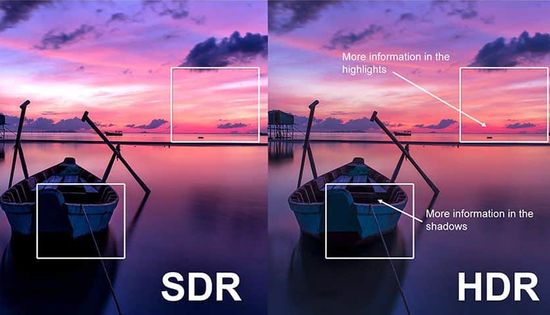
Of course, companies reacted quickly to the innovation. Already in April 2016, the UHD Alliance industry group, including LG, Samsung, Sony, Panasonic, Dolby, etc announced the adoption of Ultra HD Premium certification for UHD Blu-ray players. For several years of rapid development, support for this technology has become mandatory even for the mid-budget segment. Almost all modern TVs support at least one of the HDR standards, including HDR 10, HDR 10+, HDR10 Pro or HLG (Hybrid Log-Gamma). Of course, using dynamic data instead of statistical data required an increase in bandwidth due to the dramatic increase in data volume. But companies have successfully solved this problem with< a href="https://theappliancesreviews.com/what-is-hdmi-technology/">HDMI 2.1 standard.
OLED vs LED LCD
But the rapid development of HDR has posed a new challenge for developers of traditional LED LCDs and more innovative “quantum dot” TVs, including Samsung QLED, LG NanoCell, Sony Triluminos and ULED (Hisense). All Quantum Dot models are based on the use of an additional matrix with inorganic crystals, which improves color accuracy and expands the color gamut. But unlike OLEDs with self-emitting organic diodes, they all require backlight.
In an OLED matrix, each pixel is controlled separately using a diode control voltage. Accordingly, the absence of a control signal from the transistor provides an absolutely black on the screen, and its contrast reaches infinity. Plus, the OLED panels are very thin due to the lack of backlight. On the other hand, OLED TVs are expensive, limited in maximum brightness, their green diodes degrade over time, etc. Of course, LG, which dominates the development of OLED technology, has successfully solves these issues. For example, the company already offers 55-inch OLED models from $ 1,000, which was unrealistic just a few years ago.
LED LCD TVs are significantly cheaper, brighter and more reliable, but they cannot provide absolute black due to the diffuse glow of the backlight. As a result, the quality of their HDR mode is significantly inferior to OLED technology.
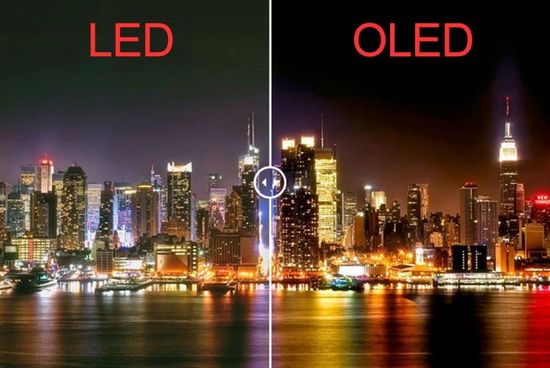
Some years ago, the popularity of ultrathin screens provoked the development of edge LED backlight with the placement of LEDs around the screen perimeter. Moreover, the LED Plus version even supported local dimming for small areas. Unfortunately, this elegant engineering solution is accompanied by uneven screen brightness and does not support brightness control across the entire screen.
Backlight evolution
But in 2018 LG developed and introduced FALD (Full Array Local Dimming) with LEDs behind the screen. As the name implies, Local Dimming technology provides backlight control for individual groups of pixels.
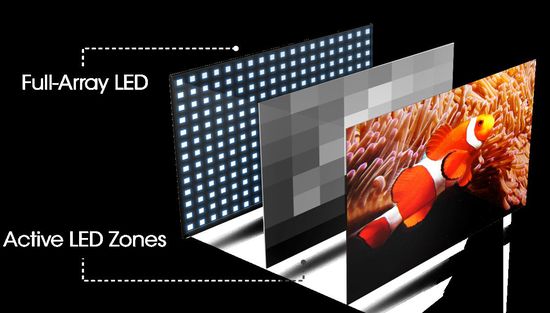
In fact, it turns off the necessary LEDs in the backlight, increasing the black level in the corresponding part of the screen and, accordingly, increasing the image contrast.
Ideally, the number of Local Dimming zones should match the number of pixels. In other words, the control system must control each backlight LED for each pixel. Then the display will provide maximum contrast and color accuracy, displaying all dark gradations. In this case, the contrast of LED and OLED TVs will be the same. But, of course, no one poses such an unrealistic task, given more than 33 million pixels on an 8K panel. However, increasing the number of dimming zones is one of the main directions for improving backlight.
In fact, Mini LED technology uses a large number of tiny LEDs to control brightness and create contrast between different frame areas on the screen. Of course, its performance directly depends on the number of Local Dimming zones, which, in turn, depends on the number of LEDs, which, in turn, depends on their size.
Therefore, increasing the number of LEDs by reducing their size has become the next direction for backlight improving. In principle, miniature LEDs have been available for a long time. But they provide low brightness. Of course, increasing the current / voltage can solve this problem, but in this case there is a problem of overheating and shortening their service life. Nevertheless, the difficulties did not stop the Chinese giant TCL, which has been leading the development of this direction for several years.
TCL mini-LED evolution
In 2018 TCL introduced the legendary TCL 6-Series Roku TV with Contrast Control Zones technology. TVs with this technology were able to increase the number of Local Dimming zones from 72 to 96 for the 55″ TV and up to 120 zones for the 65″ version. As a result, the 6 series with excellent color rendering and contrast has become one of the most popular TVs in the price range up to $ 1,000.
But the company did not stop there and already at CES 2019 introduced TCL 8-Series Roku TV with the most innovative mini-LED Quantum Contrast technology. Engineers were able to place over 25,000 backlight mini-LEDs, which are grouped into around 1,000 dimming zones.
In comparison, the 75-inch Vizio Quantum X provides only 485 local dimming zones, and the Sony XBR-85Z9G 8K TV costing about $ 10,000 has 720 zones.
The Quantum Contrast uses mini-LEDs measuring up to 200 microns (0.01 inches). In comparison, the size of conventional LEDs varies around 1,000 microns (0.04 inches).
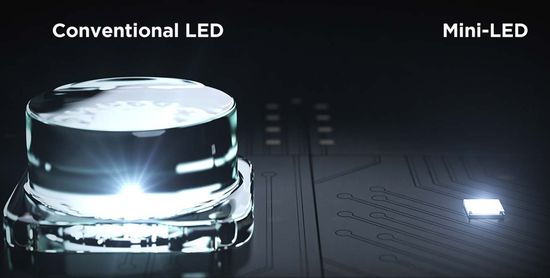
Finally, at CES 2020, TCL announced the next-generation Vidrian “Glass on LED” Mini-LED technology. This technology uses the driving semi-conductor circuitry and tens of thousands of mini-LEDs directly infused in a crystal-clear glass substrate.
But CES 2021 unexpectedly showed tremendous progress by other industry leaders in this direction. Of course, new generation OD-Zero Mini-LED from the Chinese giant is admirable, but probably Samsung’s Neo QLED Mini-LED and LG’s QNED Mini-LED will be able to compete successfully with another innovative breakthrough in TCL TVs.
LG QNED MiniLED
In addition to the transparent OLED LG Display and the innovative LG OLED EVO, the company introduced LG QNED with nearly 30,000 mini LEDs, which are grouped into nearly 2,500 local dimming zones.
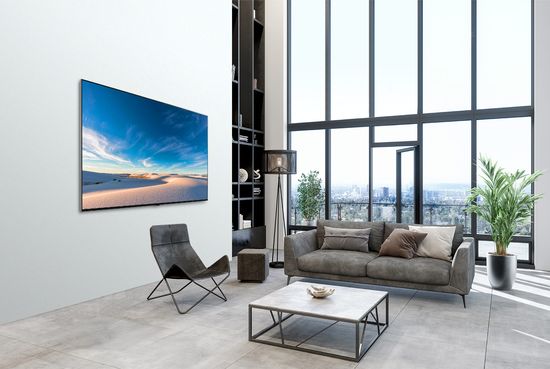
LG describes its new TVs succinctly: Quantum Dot + NanoCell + Mini LED = The Ultimate LCD TV. The acronym QNED stands for “quantum nano-emitting diode”.
According to the company, their contrast ratio reaches 1,000,000: 1! In addition, the new technology provides a significant increase in peak brightness.
The company announced QNED99, QNED95, QNED90, and QNED85 under its NanoCell branding. 99 and 95 episodes are 8K TVs, and the latter two are 4K TVs. All series are available in 65-inch and 75-inch sizes. Additionally, the company offers the QNED99 and QNED90 in 86-inch sizes.
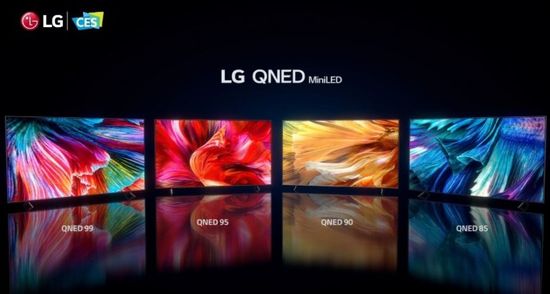
4K models have a mid-spec a7 Gen 4 AI processor, 8K QNED TVs use highest-spec a9 Gen 4 AI processor. Refresh Rate for different series varies in the range of 60-90 Hz. The real resolution of 4K TVs reaches 3,840 × 2,160 pixels, 8K – 7,680 × 4,320.
According to preliminary data, these TVs will be available from Q2 2021 with a price of $ 1,000 and up for the cheapest QNED model.
Probably, LG QNED MiniLED can be positioned as the next generation of LG NanoCell TVs with increased performance. Sure, their picture quality will be inferior to the more expensive LG OLED TVs, but hopefully the price will make up for that difference.
TCL OD-Zero (Optical Depth Zero) MiniLED
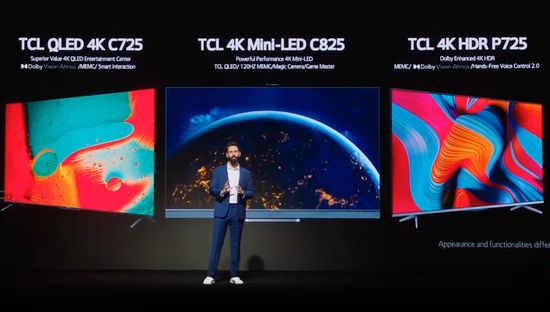
As known, at CES 2020, TCL first announced Vidrian technology, which fusing the LEDs of backlights and circuitry directly into the glass substrate of the panel (“Powered by Mini-LED on Glass Technology”). This technology minimizes the filters between the backlight and LEDs, increasing brightness and overall clarity.
OD Zero can be positioned as the third-generation miniLED technology. OEM (original equipment manufacturer) claims to have reduced the gap between the backlight and diffuser plates (termed optical distance, or the OD of the new spec’s name) to “zero millimeters”. More precisely, the company indicates 151 microns (the thickness of new miniature LEDs). For comparison, the outer diameter in QLED panels is about 12mm.

Thus, the Optical Depth Zero name highlights the near absence of a gap between the backlight and LCD display layer in TVs featuring this technology.
According to the company, OD Zero Mini LED uses the smallest LED chip in the industry, and its miniaturization doubles the number of Local Dimming Zones. As a result, the company has increased the precision contrast control, output and light uniformity of the backlight while increasing the contrast ratio and brightness.
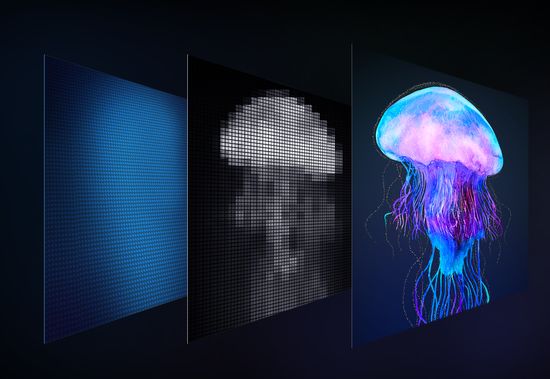
In addition to increasing the number of Local Dimming zones and increasing brightness, this breakthrough could be the next step in further reducing the thickness of LCD TVs.
Today TCL develops, integrates and manufactures almost all components in its own factories.
OD Zero technology may appear in TCL’s 2021 QLED smart TVs, which will come with Google TV.
Samsung Neo QLED MiniLED
Unexpectedly for many, at CES 2021 the permanent leader unveiled huge progress in mini LED backlight for Samsung’s new Neo QLED MiniLED TVs lineup.
The innovative Quantum Mini LED backlight panel is 40 times thinner than previous counterparts.
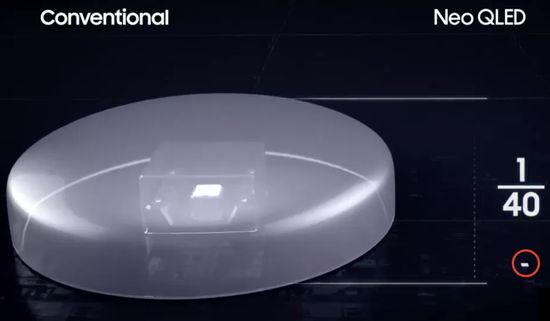
It uses the thinnest layers with a large number of miniature LEDs, the number of which has increased by about 10 times. Accordingly, the new technology allowed developers to increase the number of Local Dimming Zones in a similar proportion. Thus, their number should increase to 5000 vs 500 in previous Samsung models. Of course, this should radically improve the playback quality of HDR content.
Moreover, Neo QLED technology supports 12-bit brightness with 4096 gradations, bringing the contrast of the LCD panel closer to OLED technology.
In addition, multi-Intelligence Deep Learning technology has significantly increased the quality of upscaling to 8K by using the powerful patented Neo Quantum processor, which can use up to 16 neural network databases.
Neo QLED 8K TVs have a new Infinity One design with an almost bezel-less screen.
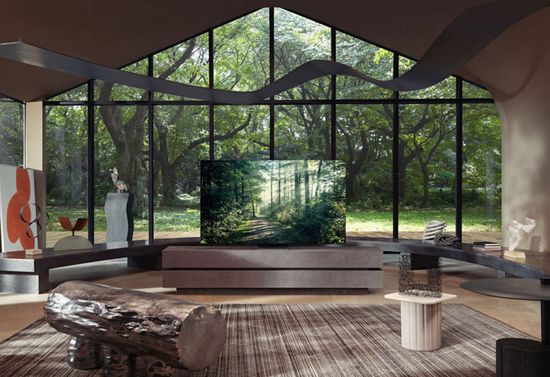
In addition, the Neo QLED 8K uses Object Tracking Sound Pro technology (sound displacement based on the movement of its source in the frame), and SpaceFit Sound (sound optimization depending on the room geometry).
New smart features:
– Samsung Health app with Smart Trainer function – personal interactive trainer with voice control;
– Super Ultrawide GameView mode extends 21: 9 format to 32: 9; Game Bar simplifies game settings;
– Google Duo service;
– PC on TV function with MS Office 365 support via TV web browser.
Preliminary, the Samsung Neo QLED MiniLED lineup will include:
– 65, 75 and 85-in 8K N800A and N900A;
– 50, 55, 65, 75 and 85-in 4K QN85A, 50QN90A and QN95A TVs.
Conclusion
Despite the quarantine, online CES 2021 perfectly demonstrated all the achievements of the industry leaders. Improving image quality by increasing the number of Local Dimming Zones in LCD models has become one of the dominant trends in 2021. The developers have successfully solved this problem by miniaturization of LEDs in FALD (full-array local dimming). Of course, a correct comparison of the quality gain in Samsung Neo QLED vs LG QNED vs TCL OD-Zero will require a careful comparison of real models, taking into account their price. But, in any case, these technologies should significantly improve the playback quality of HDR content while reducing the TV thickness.
This video showcases the new 12 Bit Samsung QN900A Neo QLED 8K.
P.S.
The past year has partly clarified the situation with the miniLED backlit announced at CES 2021. In fact, the market has formed a new segment of premium LCD TVs that use Quantum Dots technology under various names (Samsung – QLED, LG – NanoCell, Hisense – ULED, etc), and Full Array Local Dimming (FALD) based on miniature LEDs (miniLED backlit). This technology very effective enhances the overall image contrast. In particular, testing demonstrates:
– Samsung Neo QN90A – 3,510: 1 (native contrast) / 26,534: 1 (with local dimming);
– LG QNED90 – 1,127: 1 / 6,018: 1;
– TCL R646 (2021) – 8,542: 1 / 19,300: 1;
– Hisense U8G – 5,279: 1 / 7,923: 1.
But today companies limit the number of local dimming zones. For example, LG and Samsung models usually use up to 1000 zones, depending on the screen size. Few 8K miniLED TVs have over 1000 zones.
This is primarily due to a sharp increase in processor performance requirements. In fact, it has to process the frame content and, based on its analysis, adjust the backlight for each zone. With its insufficient performance, TV forms ghosting behind fast-moving objects.
Unfortunately there is no information available today on the 85-inch TCL X12 8K Starlight Smart Screen. This Chinese miracle with OD-Zero miniLED backlit was announced on March 9th at the Spring News Online Conference. The model uses an unprecedented 96,000 LED chips grouped into 1920 local dimming zones, providing 10,000,000: 1 contrast.
But in the future, miniLED backlit may face very stiff competition from Dual Cell technology, which uses an additional monochromatic layer as local dimming for the RGB layer. For example, Hisense U9DG with this technology provides 24,775: 1 (native contrast) / 31,169: 1 (contrast with local dimming).
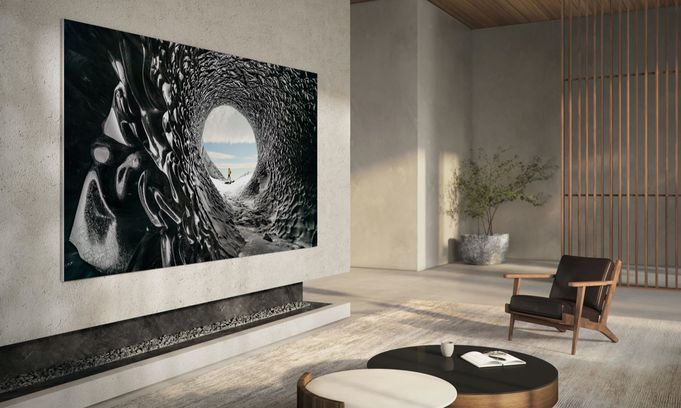
Pingback: Latest LG TVs at CES 2021 Review - The Appliances Reviews
Will the TCL Vidrian or the od zero remove the problem of poor color production when watching at an angle from the TV set .It is the main reason why I have not bought any TCL so far.Gene
OLED technology is the undisputed leader in this aspect, providing up to 180 degrees horizontally and vertically without color distortion. LСD models with IPS (in-plane switching) matrix take the second place. TVs with VA (Vertical Alignment) matrix provide only 120 degrees vertically.
For reference: the maximum value in the specs corresponds to 10% of the contrast level, but does not guarantee the preservation of bright and saturated colors. In fact, viewing angle refers to a decrease in contrast to 10: 1. But some manufacturers specify a value to decrease the contrast level to 5: 1 and only for the screen center. Therefore, this parameter in the specs does not account for distortion when viewed diagonally (bottom-up and sideways).
Of course, all the developers of TVs with the innovative mini-LED lighting promise significant improvement in viewing angles. In theory, this is true, because the technology increases contrast by increasing the number of Local Dimming zones. But a real assessment will be possible only after real TVs with this technology appear on sale.
Pingback: Samsung Neo QLED TVs at CES 2021 Review - The Appliances Reviews
Pingback: Newest robot vacuums at CES 2021 Review - The Appliances Reviews
Pingback: Projector vs TV: new Epson EpiqVision EF12 streaming laser projector - The Appliances Reviews
Pingback: Evolution Continues: Samsung TVs CES 2021 Review - The Appliances Reviews
Pingback: Innovative eye protection technologies when working with display Review - The Appliances Reviews
Pingback: Reasons for low HDR mode performance in TVs Review - The Appliances Reviews
Pingback: Living room projector vs TV Review - The Appliances Reviews
Pingback: Hisense TVs 2021 Review - The Appliances Reviews
Pingback: VA vs IPS vs ADS panel in TVs Review - The Appliances Reviews
Pingback: Time to compare Samsung QN85A vs LG QNED90 vs Samsung QN90A. Review - The Appliances Reviews
Pingback: New generation: Samsung Neo QLED vs LG QNED with mini LED Review - The Appliances Reviews
Pingback: Sony BRAVIA XR TVs with Cognitive Processor Review - The Appliances Reviews
Pingback: Hisense Mini-LED 8K TV 75U9G Review - The Appliances Reviews
Pingback: The best big screen TVs 2021 to buy. Review - The Appliances Reviews
Pingback: LG OLED vs Samsung Neo QLED TVs 2021 Review - The Appliances Reviews
Pingback: New bestsellers: TCL 6 Series (R646) vs Hisense U8G. Review - The Appliances Reviews
Pingback: All TCL TVs 2021 Review - The Appliances Reviews
Pingback: LG QNED MiniLED TVs 2021 Review - The Appliances Reviews
Pingback: LG TVs at CES 2022 Review - The Appliances Reviews
Pingback: QD-OLED TVs at CES 2022 - The Appliances Reviews
Pingback: Sony A80J vs Sony A90J OLED TV Review - The Appliances Reviews
Pingback: Hisense U8G ULED 4K Android Smart TV Review - The Appliances Reviews